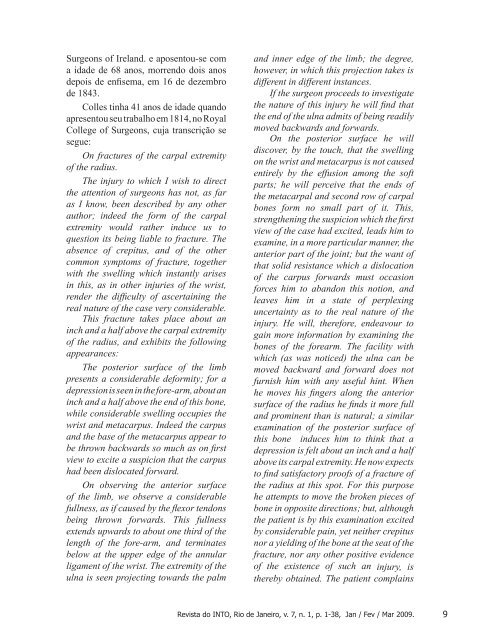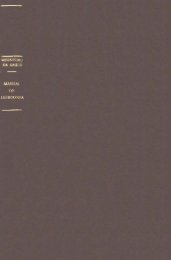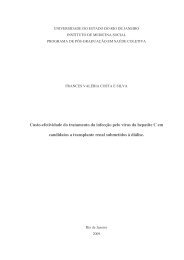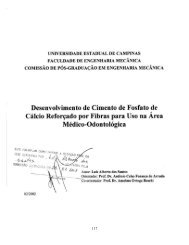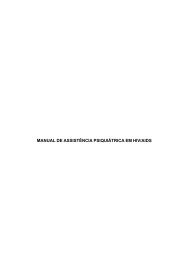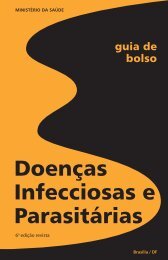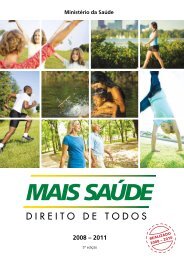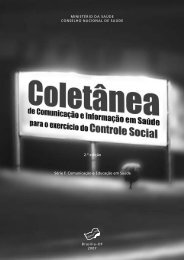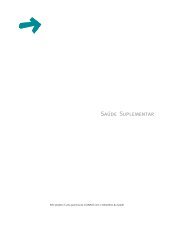Revista do INTO - BVS Ministério da Saúde
Revista do INTO - BVS Ministério da Saúde
Revista do INTO - BVS Ministério da Saúde
You also want an ePaper? Increase the reach of your titles
YUMPU automatically turns print PDFs into web optimized ePapers that Google loves.
Surgeons of Ireland. e aposentou-se com<br />
a i<strong>da</strong>de de 68 anos, morren<strong>do</strong> <strong>do</strong>is anos<br />
depois de enfisema, em 16 de dezembro<br />
de 1843.<br />
Colles tinha 41 anos de i<strong>da</strong>de quan<strong>do</strong><br />
apresentou seu trabalho em 1814, no Royal<br />
College of Surgeons, cuja transcrição se<br />
segue:<br />
On fractures of the carpal extremity<br />
of the radius.<br />
The injury to which I wish to direct<br />
the attention of surgeons has not, as far<br />
as I know, been described by any other<br />
author; indeed the form of the carpal<br />
extremity would rather induce us to<br />
question its being liable to fracture. The<br />
absence of crepitus, and of the other<br />
common symptoms of fracture, together<br />
with the swelling which instantly arises<br />
in this, as in other injuries of the wrist,<br />
render the difficulty of ascertaining the<br />
real nature of the case very considerable.<br />
This fracture takes place about an<br />
inch and a half above the carpal extremity<br />
of the radius, and exhibits the following<br />
appearances:<br />
The posterior surface of the limb<br />
presents a considerable deformity; for a<br />
depression is seen in the fore-arm, about an<br />
inch and a half above the end of this bone,<br />
while considerable swelling occupies the<br />
wrist and metacarpus. Indeed the carpus<br />
and the base of the metacarpus appear to<br />
be thrown backwards so much as on first<br />
view to excite a suspicion that the carpus<br />
had been dislocated forward.<br />
On observing the anterior surface<br />
of the limb, we observe a considerable<br />
fullness, as if caused by the flexor ten<strong>do</strong>ns<br />
being thrown forwards. This fullness<br />
extends upwards to about one third of the<br />
length of the fore-arm, and terminates<br />
below at the upper edge of the annular<br />
ligament of the wrist. The extremity of the<br />
ulna is seen projecting towards the palm<br />
and inner edge of the limb; the degree,<br />
however, in which this projection takes is<br />
different in different instances.<br />
If the surgeon proceeds to investigate<br />
the nature of this injury he will find that<br />
the end of the ulna admits of being readily<br />
moved backwards and forwards.<br />
On the posterior surface he will<br />
discover, by the touch, that the swelling<br />
on the wrist and metacarpus is not caused<br />
entirely by the effusion among the soft<br />
parts; he will perceive that the ends of<br />
the metacarpal and second row of carpal<br />
bones form no small part of it. This,<br />
strengthening the suspicion which the first<br />
view of the case had excited, leads him to<br />
examine, in a more particular manner, the<br />
anterior part of the joint; but the want of<br />
that solid resistance which a dislocation<br />
of the carpus forwards must occasion<br />
forces him to aban<strong>do</strong>n this notion, and<br />
leaves him in a state of perplexing<br />
uncertainty as to the real nature of the<br />
injury. He will, therefore, endeavour to<br />
gain more information by examining the<br />
bones of the forearm. The facility with<br />
which (as was noticed) the ulna can be<br />
moved backward and forward <strong>do</strong>es not<br />
furnish him with any useful hint. When<br />
he moves his fingers along the anterior<br />
surface of the radius he finds it more full<br />
and prominent than is natural; a similar<br />
examination of the posterior surface of<br />
this bone induces him to think that a<br />
depression is felt about an inch and a half<br />
above its carpal extremity. He now expects<br />
to find satisfactory proofs of a fracture of<br />
the radius at this spot. For this purpose<br />
he attempts to move the broken pieces of<br />
bone in opposite directions; but, although<br />
the patient is by this examination excited<br />
by considerable pain, yet neither crepitus<br />
nor a yielding of the bone at the seat of the<br />
fracture, nor any other positive evidence<br />
of the existence of such an injury, is<br />
thereby obtained. The patient complains<br />
<strong>Revista</strong> <strong>do</strong> <strong>INTO</strong>, Rio de Janeiro, v. 7, n. 1, p. 1-38, Jan / Fev / Mar 2009.


